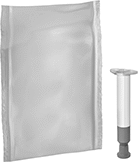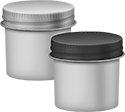About Structural Adhesives
More
Low-Melting-Point Solder for Low-Temperature Applications

Even as temperatures approach absolute zero, this indium solder remains soft and malleable, allowing it to form an airtight seal between metal and certain non-metal materials. It’s often used in cryogenic applications, including those with liquid nitrogen. This solder has a lower melting point than most solders, so it’s good for sensitive assemblies, such as semiconductors and electronic components. Unlike commonly used tin-based solders, this solder won’t damage gold plating on circuit boards. It’s also a good conductor of heat and electricity. More durable than standard tin-lead solder, this solder is less likely to crack from repeated temperature swings. It’s low outgassing, so it’s good for use in high-vacuum applications.
This indium-based solder can be cold welded, meaning it will bond to itself without heat. You can also use it for step soldering with traditional solders. It does not have a flux core; choose soldering flux to prepare workpieces for this solder.
Leaded solder has greater tensile strength and density than other indium-based solders, giving it a stronger hold.
Lead-free solder is safer to use than leaded solder and helps meet industry regulations. Solder that is 100% indium has better thermal conductivity than solder that contains tin, and will cold weld more easily. However, it has lower tensile and shear strength than solder with tin. Solder with 48% tin has greater tensile and shear strength than 100% indium solder, but lower thermal and electrical conductivity.
Material Composition | ||||||||||
|---|---|---|---|---|---|---|---|---|---|---|
| Solder Composition | Indium | Lead | Silver | Melting Temperature, °F | Thermal Conductivity, W/m-°C | Tensile Strength, psi | Diameter | Weight, oz. | Each | |
For Joining Aluminum, Brass, Bronze, Ceramic, Glass, Gold, Nickel Alloys, Quartz, Stainless Steel, Steel, Zinc | ||||||||||
| In80Pb15Ag5 | 80% | 15% | 5% | 310° | 43 | 2,550 | 0.030" | 0.16 | 0000000 | 0000000 |
Material Composition | ||||||||||
|---|---|---|---|---|---|---|---|---|---|---|
| Solder Composition | Indium | Tin | Lead | Melting Temperature, °F | Thermal Conductivity, W/m-°C | Tensile Strength, psi | Diameter | Weight, oz. | Each | |
For Joining Aluminum, Brass, Bronze, Ceramic, Glass, Nickel Alloys, Quartz, Stainless Steel, Steel, Zinc | ||||||||||
| In52Sn48 | 52% | 48% | 0% | 245° | 34 | 1,720 | 0.030" | 0.11 | 0000000 | 0000000 |
| In100 | 100% | __ | 0% | 315° | 86 | 270 | 0.030" | 0.11 | 0000000 | 000000 |
Low-Melting-Point Solder Ribbon for Low-Temperature Applications

Made with indium this solder is soft and malleable—even as temperatures approach absolute zero—allowing this solder to form an airtight seal between metal and certain non-metal materials. It’s often used in cryogenic applications, including those with liquid nitrogen. Thanks to its ribbon shape, this solder is easier to use on large, flat areas than wire solder.
This solder has a lower melting point than most solders, making it good for sensitive assemblies, such as semiconductors and electronic components. Unlike commonly used tin-based solders, this solder won’t damage gold plating on circuit boards. It’s also a good conductor of heat and electricity. More durable than standard tin-lead solder, this solder is less likely to crack from repeated temperature swings. It’s low outgassing, so you can also use it in high-vacuum applications.
This indium-based solder can be cold welded, meaning it will bond to itself without heat. You can also use it for step soldering with traditional solders. It does not have a flux core, choose soldering flux to prepare workpieces for this solder.
Leaded solder has greater tensile strength and density than other indium-based solders, giving it a stronger hold.
Lead-free solder is safer to use than leaded solder and helps meet industry regulations.
Material Composition | ||||||||||||
|---|---|---|---|---|---|---|---|---|---|---|---|---|
| Solder Composition | Indium | Lead | Silver | Melting Temperature, °F | Thermal Conductivity, W/m-°C | Tensile Strength, psi | Length | Width | Thickness | Weight, oz. | Each | |
For Joining Aluminum, Brass, Bronze, Ceramic, Glass, Gold, Nickel Alloys, Quartz, Stainless Steel, Steel, Zinc | ||||||||||||
| In80Pb15Ag5 | 80% | 15% | 5% | 310° | 43 | 2,550 | 12" | 1" | 0.002" | 0.1 | 0000000 | 0000000 |
Material Composition | ||||||||||||
|---|---|---|---|---|---|---|---|---|---|---|---|---|
| Solder Composition | Indium | Tin | Lead | Melting Temperature, °F | Thermal Conductivity, W/m-°C | Tensile Strength, psi | Length | Width | Thickness | Weight, oz. | Each | |
For Joining Aluminum, Brass, Bronze, Ceramic, Glass, Gold, Nickel Alloys, Quartz, Stainless Steel, Steel, Zinc | ||||||||||||
| In52Sn48 | 52% | 48% | 0% | 245° | 34 | 1,720 | 12" | 1" | 0.002" | 0.1 | 0000000 | 0000000 |
| In100 | 100% | __ | 0% | 315° | 86 | 270 | 12" | 1" | 0.002" | 0.1 | 0000000 | 000000 |
Conductive Adhesives for Electronics
An alternative to solder, these flexible, silver-filled adhesives accommodate joint movement. Use them to bond electrical components and repair circuits.
Epoxy adhesives are two-part adhesives that need to be mixed together. The size listed is the combined total of the two parts.
Adhesives that meet ASTM E595, a standard used by NASA, produce almost no volatile emissions that could damage sensitive electronics, even in a vacuum.



Container | ||||||||||||||
|---|---|---|---|---|---|---|---|---|---|---|---|---|---|---|
| Mfr. Model No. | Size, fl. oz. | Net Weight, oz. | Type | Surface Resistivity, ohms-cm | Begins to Harden | Reaches Full Strength | Thermal Conductivity, W/m-K | Mix Ratio | Consistency | Max. Temp., °F | Specifications Met | For Joining | Each | |
Loctite® Adhesives | ||||||||||||||
| 2902 | __ | 0.09 | One-Time-Use Packet, Syringe | 1 × 10-3 | 60 min. | 24 hrs. | 2.99 | 100:6 | Paste | 230° | ASTM E595 | Ceramic, Glass, Metal | 00000000 | 000000 |
| 2902 | __ | 0.35 | One-Time-Use Packet, Syringe | 1 × 10-3 | 60 min. | 24 hrs. | 2.99 | 100:6 | Paste | 230° | ASTM E595 | Ceramic, Glass, Metal | 00000000 | 000000 |
Adhesives | ||||||||||||||
| __ | __ | 0.09 | One-Time-Use Packet | 5 × 10-2 | 3 hrs. | 24 hrs. | 1.55 | 1:1.15 | Paste | 230° | __ | Ceramic, Glass, Metal | 0000000 | 00000 |
| __ | 0.5 | __ | Can | 9 × 10-5 | 4 hrs. | 5 days | 7.9 | 1:1 | Paste | 175° | ASTM E595 | Ceramic, Glass, Metal | 00000000 | 000000 |
| __ | 1 | __ | Can | 9 × 10-5 | 4 hrs. | 5 days | 7.9 | 1:1 | Paste | 175° | ASTM E595 | Ceramic, Glass, Metal | 00000000 | 000000 |

























